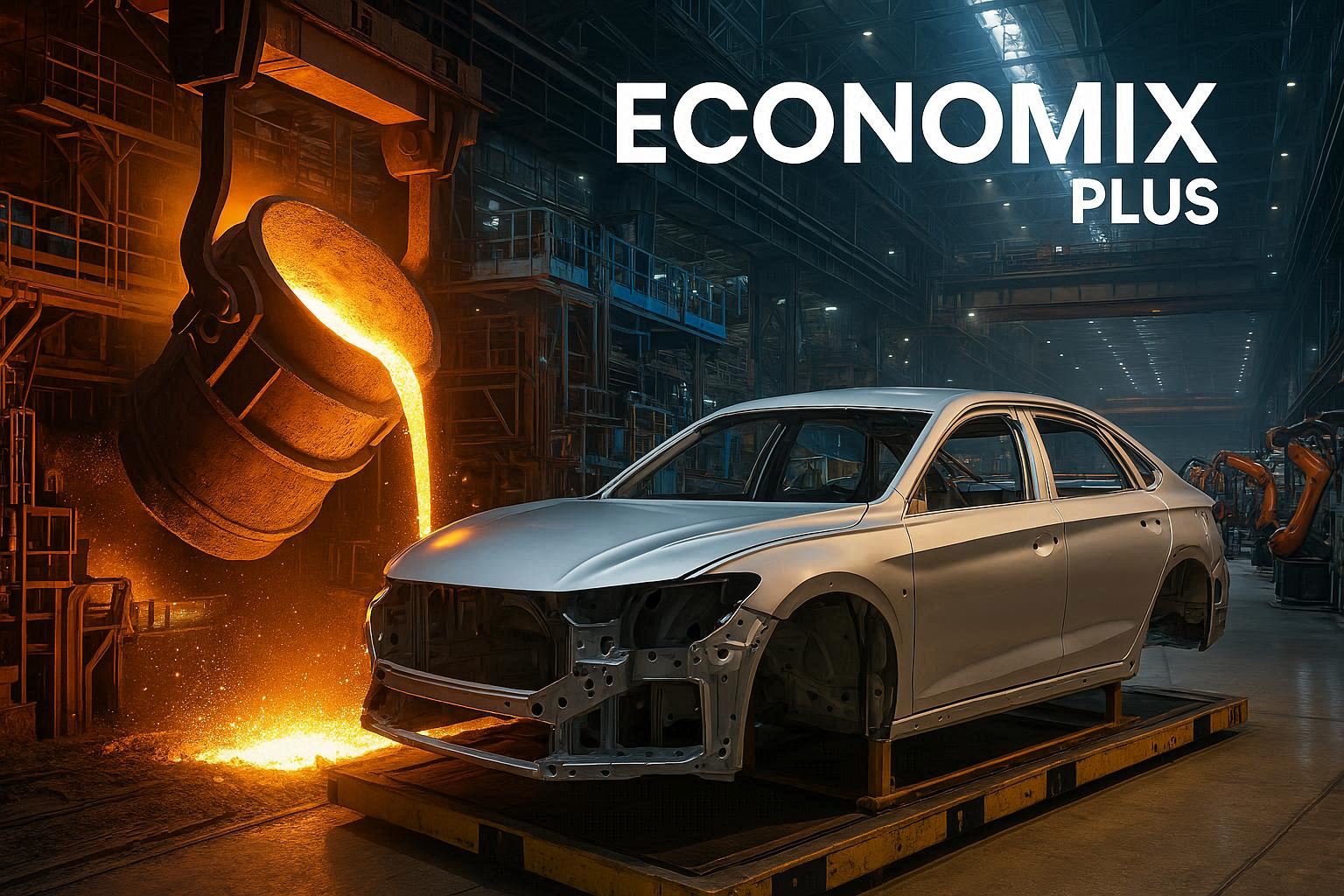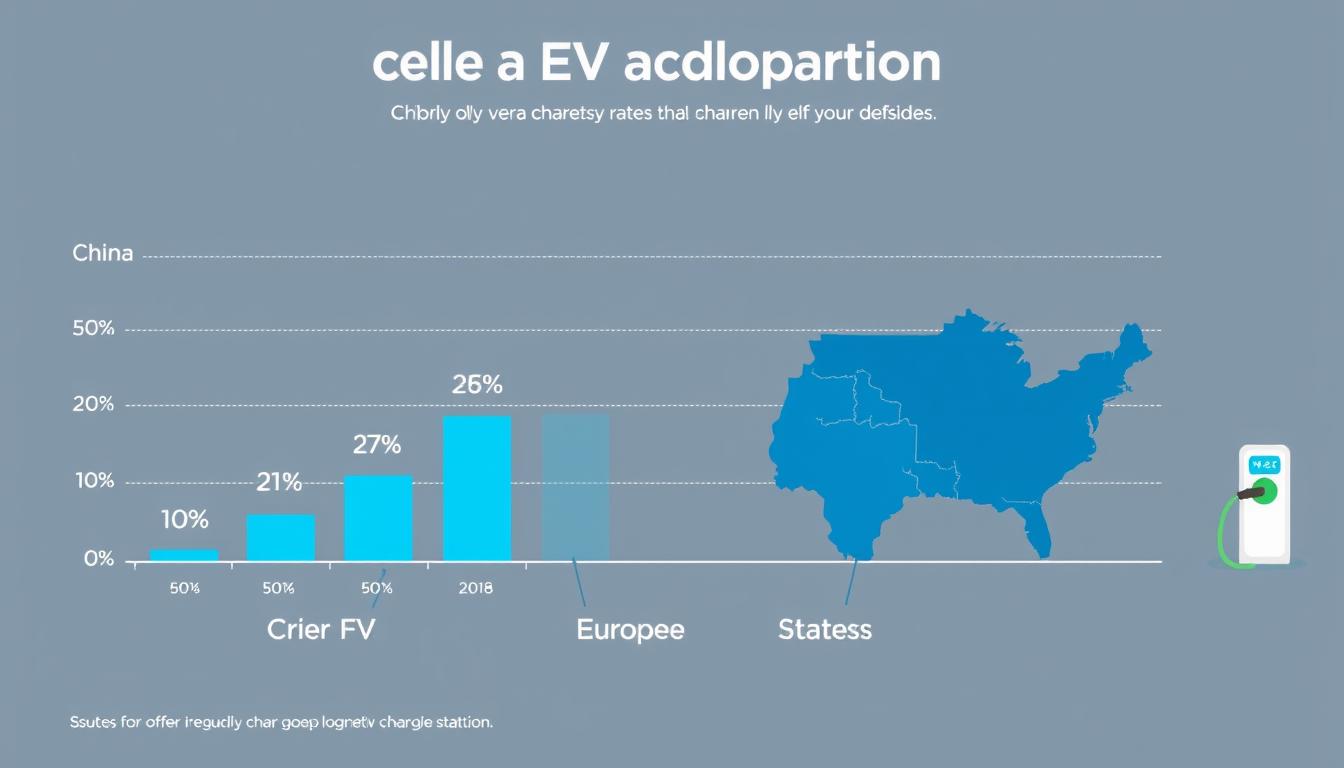What if the key to cutting 7% of global greenhouse gas emissions lies in a single innovation? The global steel industry is one of the largest contributors to carbon emissions, but a groundbreaking initiative might change that. Sweden’s HYBRIT project, led by SSAB, is pioneering a new way to produce steel without relying on coal.
This revolutionary approach uses hydrogen instead of coal in blast furnaces, significantly reducing emissions. With a $46 billion investment from LKAB, the process aims to create emissions-free iron from iron ore. Sweden’s clean energy infrastructure gives it a unique advantage in scaling this technology.
If successful, this could set a blueprint for the entire steel industry, accelerating decarbonization worldwide. But challenges remain in scaling this technology globally. Could this be the turning point for a greener future?
Key Takeaways
- HYBRIT initiative aims to revolutionize steel production using hydrogen.
- $46 billion investment supports emissions-free iron processing.
- Sweden’s clean energy infrastructure enables green steel production.
- Steelmaking accounts for 7% of global greenhouse gas emissions.
- Hydrogen-based reduction replaces coal in blast furnaces.
- Challenges exist in scaling fossil-free steel production globally.
- SSAB plans to replace all blast furnaces by 2034.
The Role of SSAB in the Steel Industry
Steel production has long been a cornerstone of industrial growth, but its environmental toll is undeniable. As one of the largest contributors to emissions, the industry is under pressure to innovate. SSAB, a leader in the field, has been at the forefront of this transformation.
SSAB’s Historical Significance
Founded in 1878, SSAB began as a state-owned enterprise focused on meeting domestic demand. Over the years, it evolved into a privatized leader, maintaining strong partnerships with governments. Its 140-year legacy is marked by continuous innovation in metallurgy.
Today, SSAB operates five blast furnaces across Sweden, with a total capacity that positions the company as a leader in the region. Its vertical integration with LKAB ensures a steady supply of high-quality iron ore.
This strategic advantage has cemented its position as a key player in the Nordic manufacturing ecosystem, as reports indicate significant growth over the years.Current Position in the Global Market
SSAB is now Europe’s fourth-largest steel producer, with an annual capacity of 8.8 million tons. Its focus on high-strength specialty steels has given it a premium market position. In 2023, the company shipped 50,000 tons of SSAB Zero™, a milestone in its journey toward decarbonization.
Compared to giants like ArcelorMittal and Chinese producers, SSAB’s niche expertise sets it apart. Its commitment to green steel production positions it as a pioneer in the industry.
| Company | Annual Production (Million Tons) | Market Position |
|---|---|---|
| SSAB | 8.8 | 4th in Europe |
| ArcelorMittal | 97.3 | Global Leader |
| Chinese Producers | 1,032.0 | Dominant in Asia |
The Global Steel Industry: Challenges and Opportunities
The global steel sector faces a critical crossroads as it balances growth with sustainability. Traditional methods, while effective, come with a heavy environmental cost. Innovations are emerging to address these challenges, offering a path toward a greener future.
Environmental Impact of Traditional Steelmaking
Conventional blast furnaces emit 1.85 tons of CO2 for every ton of steel produced. This contributes to 2.6 billion tons of annual emissions globally. The primary sources are coking coal (75%) and process heat (25%).
These emissions make the steel industry one of the largest contributors to carbon pollution. Reducing this footprint is essential for meeting global climate goals.
Emerging Trends in Steel Production
New technologies are transforming the process of making steel. Hydrogen-based reduction, for example, can cut emissions by up to 95%. Direct Reduced Iron (DRI) technology is also gaining traction, accounting for 7% of global production.
Electric Arc Furnaces (EAFs) are another alternative, especially in regions with strict emissions regulations. However, challenges like scrap steel quality degradation remain.
Policy drivers, such as the EU Carbon Border Adjustment Mechanism, are accelerating the shift toward greener methods. Raw material geopolitics, dominated by Australia and Brazil, also play a role in shaping the industry’s future.
SSAB’s HYBRIT Project: A Game Changer
Innovation in steel production is taking a bold leap forward with the HYBRIT project. This initiative, launched in 2016, aims to revolutionize the industry by replacing coal with hydrogen in the production process. The result is fossil-free steel, a cleaner alternative that could significantly reduce carbon emissions.

Overview of the HYBRIT Initiative
The HYBRIT project is a collaborative effort between three key players: SSAB, LKAB, and Vattenfall. SSAB focuses on steel production, LKAB on mining high-quality iron ore, and Vattenfall on providing renewable energy. Together, they aim to create a sustainable steelmaking process.
Since its pilot launch in Luleå, the project has achieved a 95% reduction in emissions. This success is attributed to the use of hydrogen-based direct reduction, which replaces traditional coal-powered methods. The first commercial plant is set to open in 2027, marking a major milestone.
Key Innovations and Technologies
The core of the HYBRIT project lies in its use of hydrogen to reduce iron ore. This method produces water vapor as a byproduct, unlike traditional processes that emit CO2. However, scaling this technology requires significant energy—up to 5TWh of additional electricity.
Another challenge is ensuring a continuous hydrogen supply. Despite these hurdles, the project has shown promising results. It serves as a model for regions rich in renewable energy, such as Australia and Brazil.
| Method | Emissions (CO2 per ton of steel) |
|---|---|
| H2-DRI | 0.1 |
| Natural Gas DRI | 1.2 |
The HYBRIT project is not just an innovation; it’s a blueprint for the future of steelmaking. By addressing technical and scalability challenges, it paves the way for a greener industry.
Decarbonization: The Core of SSAB’s Strategy
Cutting-edge technology is reshaping one of the most carbon-intensive industries. SSAB’s strategy focuses on reducing emissions through innovative methods. This approach is not just about sustainability but also about setting a new standard for the sector.
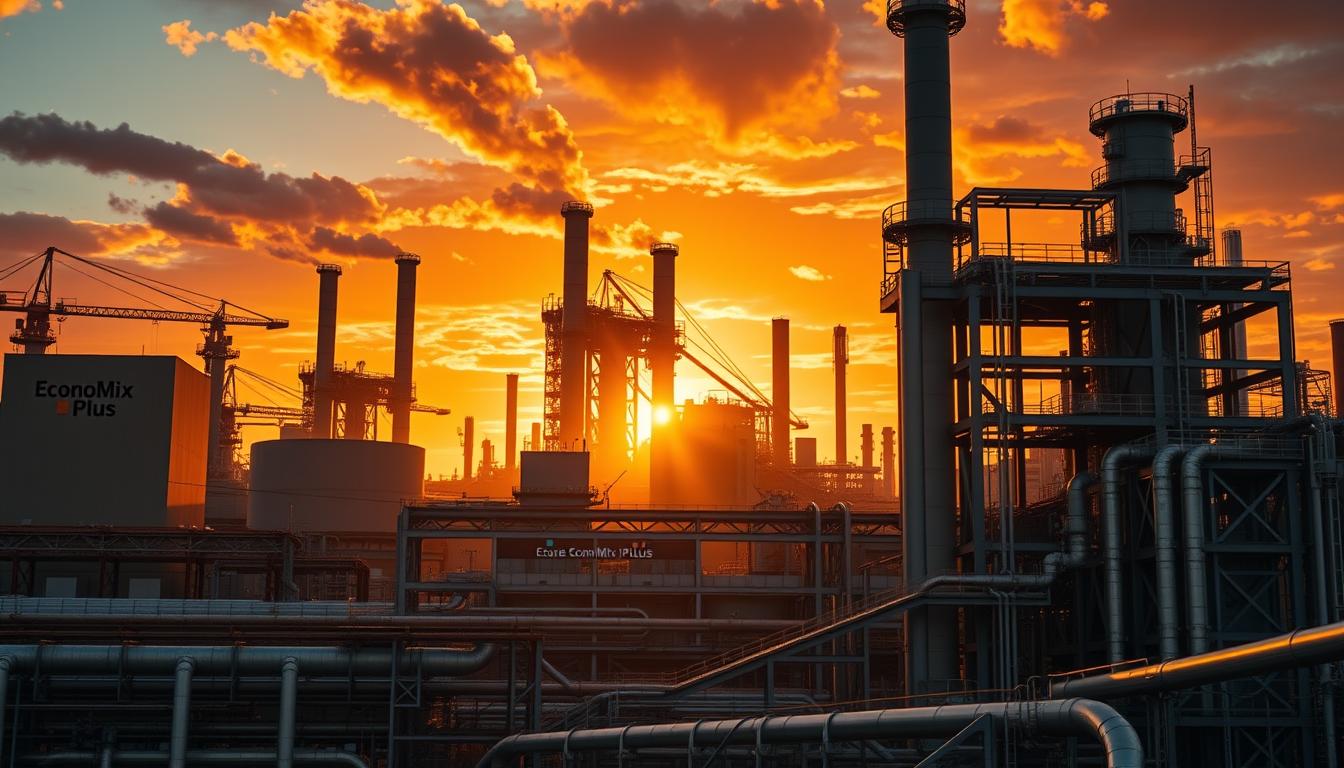
Reducing Carbon Emissions in Steelmaking
SSAB’s transition involves replacing traditional blast furnaces with electric arc furnaces (EAFs). This shift will reduce emissions by 28 million tons annually, equivalent to 50% of Sweden’s total. The company’s Nordic sites will consume 4.5TWh of electricity post-transition, up from the current 1.6TWh.
Legacy plants face challenges with carbon capture, but SSAB’s focus on renewable energy procurement ensures a cleaner process. The phase-out schedule includes converting five blast furnaces into three EAF mills. This transformation is a critical step toward achieving their 2034 goal.
Hydrogen as a Key Component
Hydrogen plays a pivotal role in SSAB’s decarbonization strategy. The purity requirement for hydrogen in direct reduced iron (DRI) processes exceeds 99.95%. This ensures efficiency and minimizes emissions.
Green hydrogen, though costlier at $4.50/kg compared to gray hydrogen at $1.50/kg, is essential for sustainability. The EU’s Emissions Trading System (ETS) is expected to drive costs higher, with carbon prices projected to reach €90/ton by 2030.
| Hydrogen Type | Cost per kg |
|---|---|
| Green Hydrogen | $4.50 |
| Gray Hydrogen | $1.50 |
SSAB’s commitment to hydrogen infrastructure positions it as a national priority. This focus not only supports decarbonization but also addresses workforce transition challenges, impacting over 1,000 jobs. The company’s SSAB Zero™ certification protocols further solidify its leadership in sustainable steel production.
The Role of Hydrogen in Steel Production
Hydrogen is emerging as a transformative force in modern steel production. This clean energy source is replacing traditional coal-based methods, offering a sustainable alternative. By using hydrogen, the process reduces harmful emissions and aligns with global climate goals.
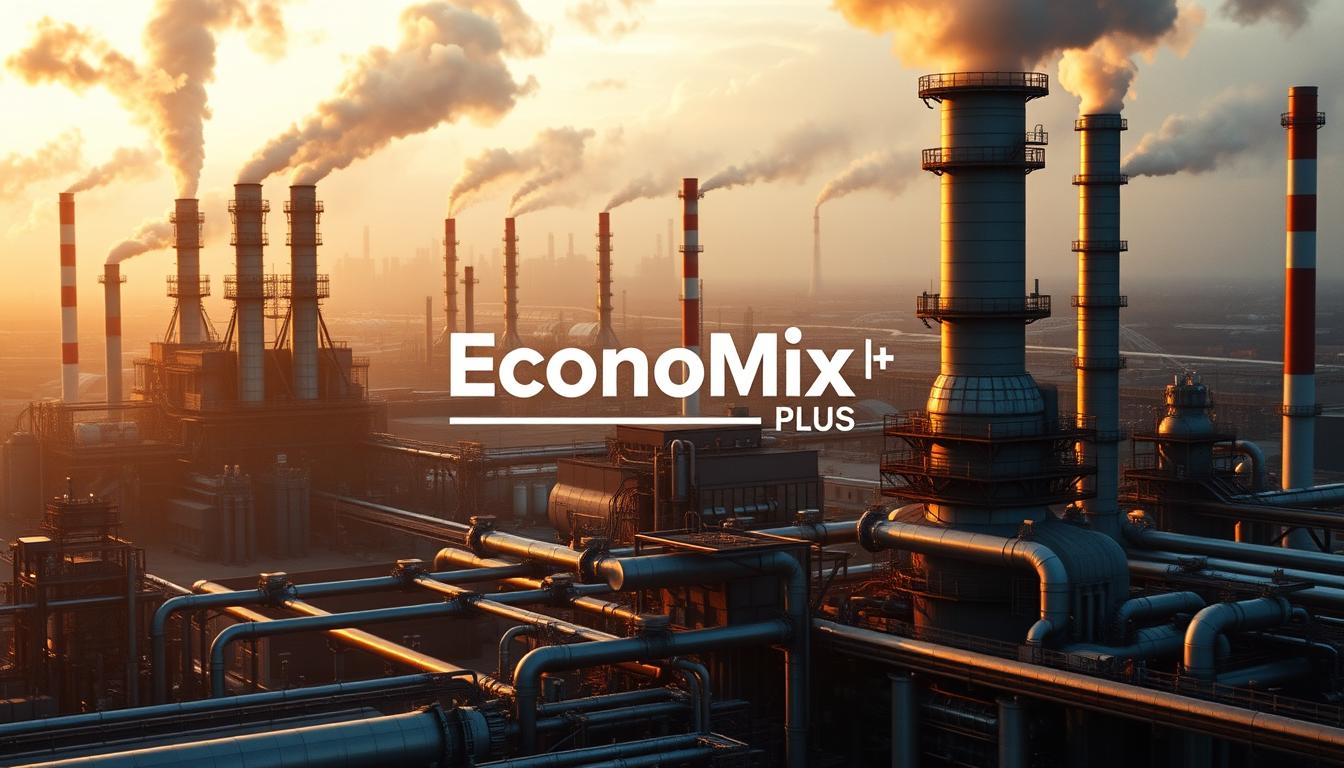
Hydrogen-Based Reduction Process
The hydrogen-based reduction method involves using hydrogen gas to convert iron ore into metallic iron. The chemical reaction is straightforward: Fe2O3 + 3H2 → 2Fe + 3H2O. This process produces water vapor instead of CO2, making it environmentally friendly.
Energy requirements are lower compared to traditional blast furnaces. Hydrogen-based direct reduction uses 12-14 GJ per ton, while blast furnaces consume 20 GJ. Additionally, the process operates at 800°C, reducing thermal energy needs.
Advantages Over Traditional Methods
Hydrogen-based steelmaking offers several benefits. It eliminates the need for coal, reducing carbon emissions by up to 95%. Modular plant designs provide flexibility, allowing for easier scaling and adaptation.
Specialty steel production benefits from the high purity of hydrogen-reduced iron. This ensures superior quality and performance. However, material handling challenges, such as managing sponge iron, must be addressed.
| Method | Energy Consumption (GJ/ton) | Temperature (°C) |
|---|---|---|
| Hydrogen DRI | 12-14 | 800 |
| Blast Furnace | 20 | 1,200 |
Hydrogen-based steelmaking is not just a technological advancement; it’s a step toward a circular economy. By leveraging renewable energy, this method supports sustainable industrial growth.
Economic Implications of SSAB’s Innovations
The shift toward sustainable steel production brings significant economic benefits. By adopting hydrogen-based methods, companies can reduce operational expenses while meeting environmental goals. This approach not only lowers costs but also enhances market competitiveness.
SSAB’s HYBRIT project is a prime example. By 2030, the company expects a €200 per ton cost advantage over traditional EU producers. This is supported by a $1.45 billion investment in the Luleå electric arc furnace (EAF). Such innovations position SSAB as a leader in the industry.
Cost Efficiency and Market Competitiveness
Hydrogen-based direct reduction (H2-DRI) costs $40 per ton, compared to $60 for traditional blast furnaces. This efficiency is further enhanced by SSAB’s premium pricing strategy, which adds 15-20% for fossil-free steel. The EU Carbon Border Adjustment Mechanism (CBAM) also strengthens import competitiveness.
Operational flexibility is another advantage. Mini-mills can adapt quickly to market demands, ensuring steady production. Additionally, domestic iron ore sourcing secures raw material supply, reducing dependency on external markets.
Long-Term Financial Benefits
The $46 billion investment by LKAB is projected to yield substantial returns. By avoiding carbon costs, SSAB could save $2.5 billion annually at €100 per ton. This aligns with the company’s goal of improving EBITDA margins by 30% by 2035.
Scrap metal integration further enhances economic viability. By recycling materials, SSAB reduces waste and lowers production expenses. This circular approach supports both financial and environmental objectives.
| Method | Cost per Ton |
|---|---|
| H2-DRI | $40 |
| Blast Furnace | $60 |
SSAB’s innovations demonstrate that sustainability and profitability can go hand in hand. By reducing emissions and cutting costs, the company is setting a new standard for the industry.
Environmental Benefits of Fossil-Free Steel

The environmental impact of steel production is under scrutiny as industries seek greener solutions. Fossil-free steel offers a promising path to reduce harmful emissions and align with global climate goals. This innovative approach not only addresses environmental concerns but also sets a new standard for sustainability.
Reduction in Greenhouse Gas Emissions
Fossil-free steel significantly cuts greenhouse gas emissions. Traditional methods produce 1,850kg of CO2 per ton, while fossil-free alternatives reduce this to just 50kg. This 95% reduction is a game-changer for industries aiming to meet climate targets.
Scope 3 emissions, particularly for automotive customers, also see a dramatic drop. By enabling net-zero supply chains, fossil-free steel supports broader reduction efforts. This positions it as a key enabler for achieving global sustainability goals.
Contribution to Global Climate Goals
Full implementation of fossil-free steel could reduce Sweden’s CO2 emissions by 10%. On a global scale, this innovation could contribute 2.5% of the Paris Agreement targets. Such progress highlights its potential to drive meaningful change.
Water usage is another area of improvement. Fossil-free steel requires only 1.4m³ per ton, compared to 2.8m³ in conventional methods. This efficiency supports biodiversity and reduces strain on natural resources.
- Lifecycle emissions drop to 50kg CO2e per ton.
- Particulate matter (PM2.5) decreases by 80%.
- By 2050, annual global emissions could fall by 500 million tons.
Fossil-free steel also aligns with EU Taxonomy regulations, ensuring compliance with stringent environmental standards. Its circular economy synergies further enhance its appeal, making it a cornerstone of sustainable industrial policy.
Technological Advancements in Steelmaking
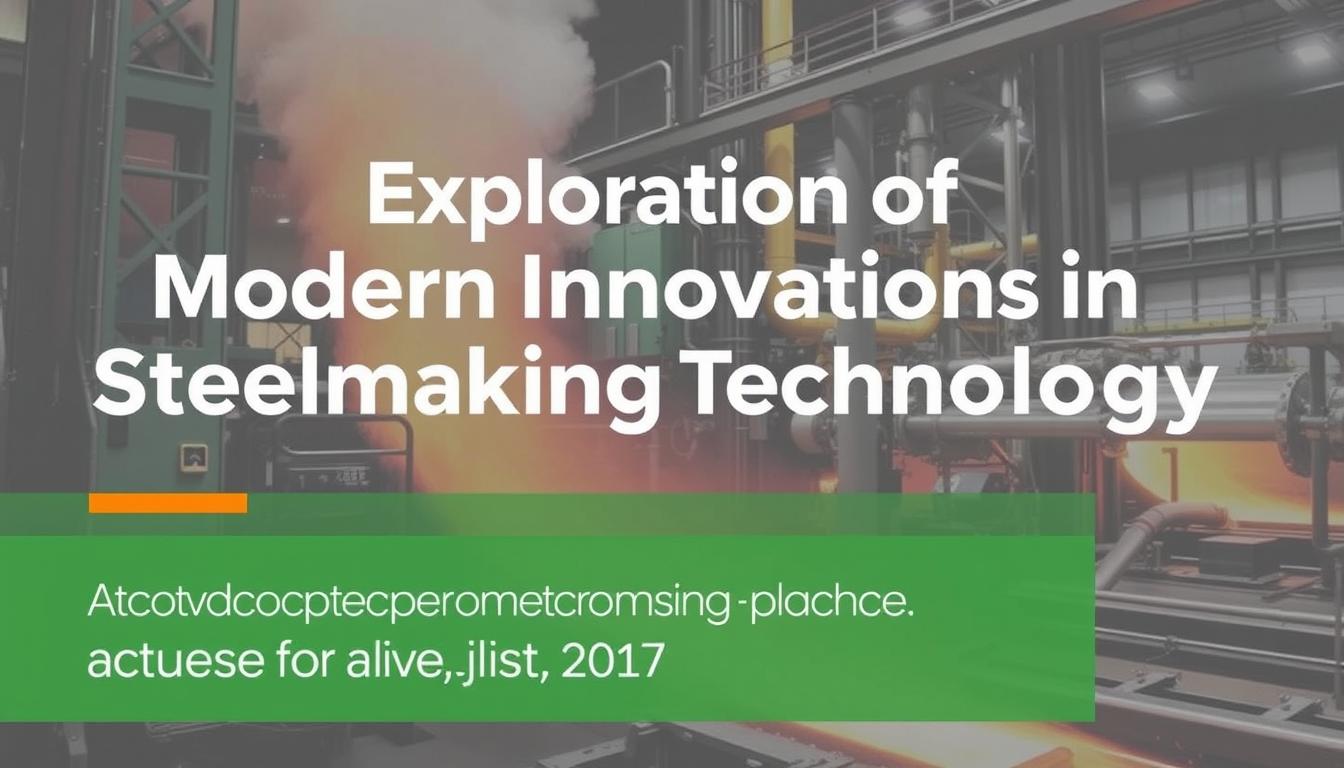
The evolution of steelmaking is being driven by cutting-edge technologies that promise a greener future. From electric arc furnaces to renewable energy integration, these innovations are transforming the industry. They not only enhance efficiency but also reduce environmental impact.
Electric Arc Furnaces and Mini-Mills
Electric arc furnaces (EAFs) are at the forefront of this transformation. The new Luleå EAF, with a 2.3Mt capacity and 300MW power draw, exemplifies this shift. It operates at 90% efficiency, significantly reducing energy consumption compared to traditional methods.
Mini-mills, which use EAFs, have a smaller footprint than integrated mills. This makes them more adaptable and cost-effective. However, their 24/7 operations pose challenges for grid stability, requiring advanced energy management systems.
Integration of Renewable Energy Sources
Renewable energy is a key component of modern steelmaking. The Luleå EAF requires 1.8TWh of renewable electricity annually. Vattenfall’s wind farm expansion plans aim to meet this demand, ensuring a sustainable energy supply.
Smart grid technologies are being deployed to balance energy consumption. These systems optimize power usage, reducing strain on the grid. Additionally, AI-powered scrap sorting systems improve material efficiency, while digital twins enhance process optimization.
- EAFs reduce energy consumption by 40% compared to blast furnaces.
- Mini-mills offer flexibility and lower operational costs.
- Smart grids ensure stable energy supply for 24/7 operations.
- AI systems improve scrap sorting accuracy by 30%.
- Digital twins optimize production processes, reducing waste.
These advancements are not just about efficiency; they represent a shift toward a circular economy. By integrating renewable energy and advanced systems, the steel industry is setting a new standard for sustainability.
SSAB’s Collaboration with LKAB and Vattenfall
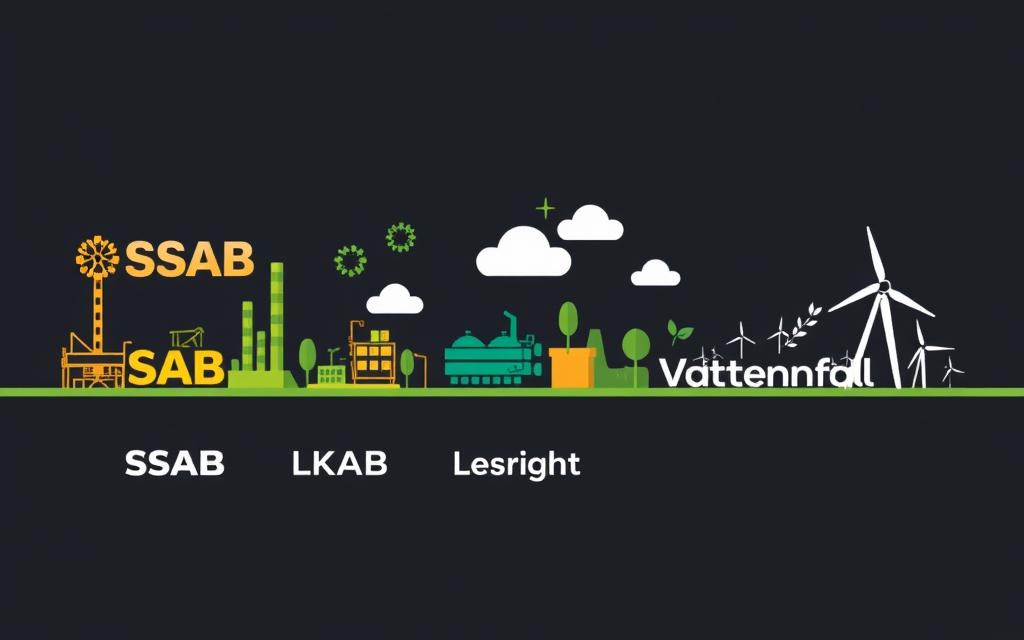
Collaboration is key to driving innovation in sustainable industrial practices. SSAB’s partnership with LKAB and Vattenfall exemplifies how shared expertise can transform an industry. Together, they are pioneering the HYBRIT project, a groundbreaking initiative to produce fossil-free steel.
The HYBRIT joint venture is equally owned by the three companies, each contributing unique strengths. SSAB focuses on steel production, LKAB on mining high-quality iron ore, and Vattenfall on renewable energy. This vertical integration ensures a seamless chain from mine to mill.
Joint Ventures and Strategic Partnerships
The HYBRIT initiative is supported by a 520M SEK investment from the Swedish Energy Agency. This funding underscores the state’s commitment to sustainable industrial practices. The collaboration also includes shared infrastructure investments, such as hydrogen production facilities and renewable energy plants.
Electricity price hedging strategies are another critical component of the decarbonization efforts in Sweden. By securing long-term renewable energy contracts, the companies mitigate cost volatility in the energy system. This ensures financial stability while advancing their sustainability goals, contributing to a 100 percent fossil-free value chain.Shared Goals and Synergies
The partners are united by a vision to create a 100% fossil-free value chain by 2040. Workforce development programs are integral to this vision, ensuring employees are equipped with the skills needed for green manufacturing. Intellectual property sharing agreements further strengthen the collaboration, fostering innovation.
Geopolitical risks in raw material security are also addressed. By sourcing iron ore domestically, the partnership reduces dependency on external markets. This enhances resilience and supports long-term sustainability.
| Partner | Contribution |
|---|---|
| SSAB | Steel Production |
| LKAB | Iron Ore Mining |
| Vattenfall | Renewable Energy |
With an annual R&D investment of €75M, the HYBRIT initiative is setting a template for industry consortia. By combining resources and expertise, SSAB, LKAB, and Vattenfall are leading the way toward a greener future.
Challenges in Scaling Up Green Steel Production
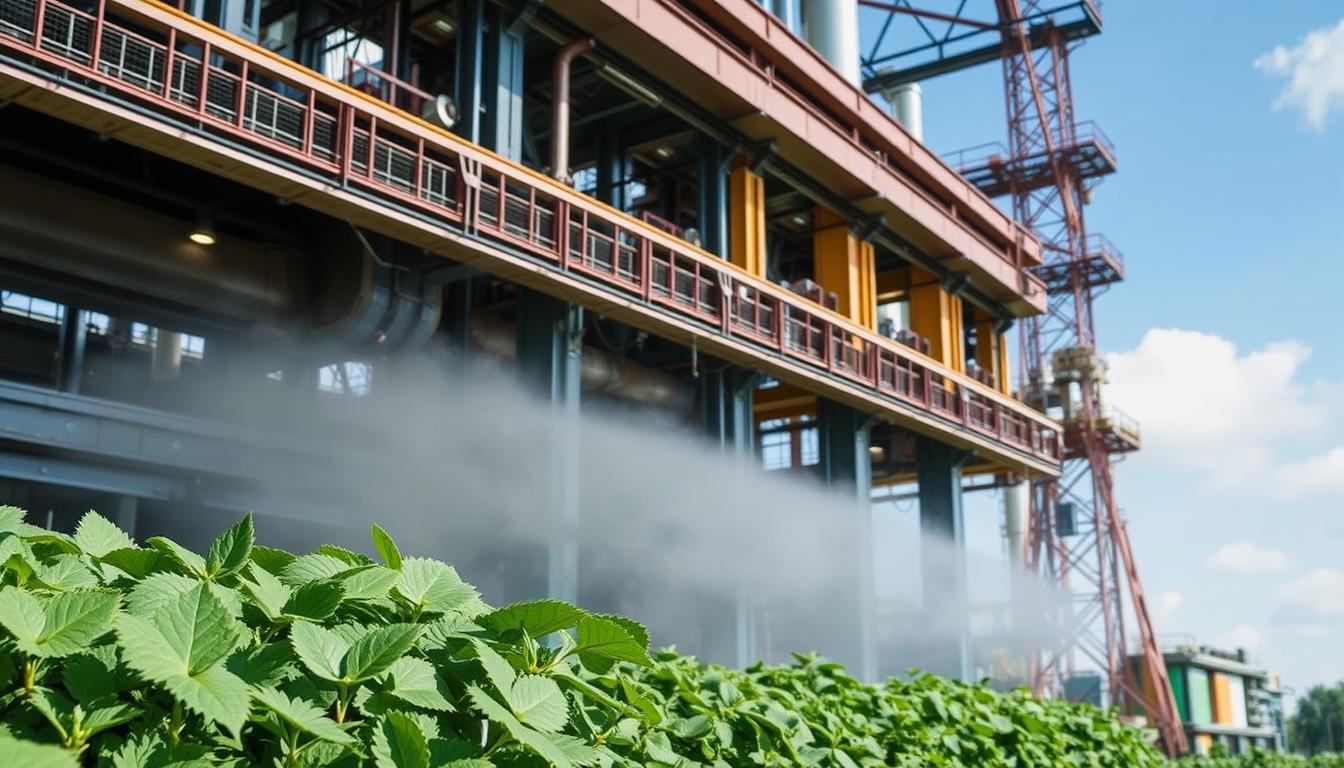
Scaling green steel production presents unique challenges that demand innovative solutions. From infrastructure upgrades to regulatory hurdles, the path to large-scale adoption is complex. Addressing these issues is critical to achieving a sustainable future for the industry.
Infrastructure and Resource Requirements
Expanding fossil-free steel production requires significant investments in infrastructure. Grid upgrades alone could cost $3.2 billion, ensuring sufficient energy supply. The process also demands 70TWh of electricity, equivalent to Sweden’s 2022 surplus.
Raw material purity is another concern. High-quality iron ore is essential for efficient hydrogen-based reduction, particularly as Sweden’s total capacity for decarbonization increases. Rare earth supply chain bottlenecks further complicate the process, delaying production timelines, especially for pilot plants that aim to scale up iron production within the year.
Skilled labor shortages add to the challenges. Over 5,000 workers are needed to support new plants and technologies. Training programs must be implemented to bridge this gap.
Regulatory and Permitting Hurdles
Environmental permitting contradictions often slow progress. For example, LKAB’s Gällivare permit took three years instead of the projected 1.5. This delay highlights the need for streamlined approval processes.
Policy misalignment within the EU taxonomy also poses issues. Competing land use, such as wind farms versus mining, further complicates planning. Concrete demand for new plants, estimated at 2 million tons, adds to the logistical challenges.
Energy costs vary across regions, with Nordic countries benefiting from lower renewable energy prices. Southern EU nations face higher expenses, impacting their ability to scale production.
- Grid upgrades require $3.2 billion investment.
- Skilled labor shortages affect over 5,000 positions.
- Environmental permitting delays extend project timelines.
- Concrete demand for new plants reaches 2 million tons.
- Energy costs differ significantly between Nordic and Southern EU regions.
By 2030, production targets aim for 5 million tons of fossil-free steel. Achieving this goal will require overcoming these challenges through collaboration and innovation.
Global Impact of SSAB’s Transformation

The transformation of steel production is reshaping industries worldwide. By pioneering fossil-free methods, SSAB is influencing how other companies approach sustainability. This shift is not just about reducing emissions but also about setting a new standard for the industry.
Influence on Other Steel Producers
SSAB’s innovations are inspiring change across the global steel sector. For example, Fortescue in Australia plans to produce 50 million tons of green steel by 2030. This reflects a growing trend among companies to adopt cleaner technologies.
Technology transfer opportunities are also emerging. Licensing models and turnkey solutions are being explored to accelerate adoption. These approaches allow producers to implement SSAB’s methods without starting from scratch.
Potential for Worldwide Adoption
The potential for fossil-free steel extends beyond developed nations. Developing countries can leapfrog traditional methods and adopt green technologies directly. This could reduce their reliance on carbon-intensive processes.
Trade policies, such as the EU Carbon Border Adjustment Mechanism (CBAM), are also driving change. By imposing tariffs on high-emission imports, these policies encourage the adoption of cleaner methods globally.
| Region | Renewable Energy Cost ($/MWh) |
|---|---|
| Sweden | 30 |
| Australia | 20 |
By 2035, fossil-free steel could capture 15% of the global market. This growth will depend on overcoming challenges like shipping costs and raw material availability. However, the benefits of reduced emissions and improved sustainability make it a worthwhile investment.
Future Prospects for the Steel Industry
The next decade will redefine how industries approach sustainability. With global demand for steel projected to reach 2.5 billion tons by 2050, the sector must adapt to meet both economic and environmental goals. Innovations in technology and policy shifts will play a pivotal role in shaping this transformation.
Predictions for the Next Decade
By 2035, green steel is expected to capture 15% of the market, according to the IEA. This growth will be driven by advancements in hydrogen-based reduction and AI-driven process optimization. Critical mineral demand is also projected to rise, with a focus on securing sustainable supply chains.
Recycling rates are set to improve, targeting an 85% recovery rate. Digital product passports will enhance traceability, ensuring transparency in material sourcing. These trends highlight the industry’s shift toward a circular economy.
Role of Policy and Innovation
Policy frameworks, such as carbon accounting standardization, will accelerate the adoption of green practices. Hydrogen pipeline infrastructure will expand, supported by investments in renewable energy. Nuclear microreactors are also being positioned to power remote production sites.
Geopolitical shifts will influence production hubs, with regions rich in renewable energy gaining prominence. The erosion of the green premium over time will make sustainable steel more accessible. As a first-mover, SSAB’s innovations serve as a case study for the industry’s future.
“The future of steel lies in balancing efficiency with sustainability. Innovation and collaboration will be key to achieving this goal.”
- Critical mineral demand will rise significantly.
- AI will optimize production processes, reducing waste.
- Hydrogen infrastructure will expand to meet growing needs.
- Recycling rates will improve to 85% by 2035.
- Digital product passports will enhance supply chain transparency.
SSAB’s Vision for a Sustainable Steel Industry
The path to a greener future lies in reimagining traditional industrial processes. HYBRIT’s innovative approach demonstrates that transformation is both technically feasible and economically viable. By achieving a 95% reduction in emissions, this initiative sets a new standard for sustainable production.
However, challenges remain, particularly in scaling energy infrastructure to meet growing demands. SSAB’s leadership in the green steel market positions it as a model for the industry. Its success underscores the need for international policy alignment to accelerate adoption globally.
As automotive and construction sectors increasingly adopt fossil-free steel, the future of industrial sustainability looks promising. With continued innovation and collaboration, achieving a net-zero pathway by 2050 is within reach. This progress highlights the critical role of steel in enabling climate solutions worldwide.
FAQ
▶
▶
▶
▶
▶
▶
▶
▶
▶

